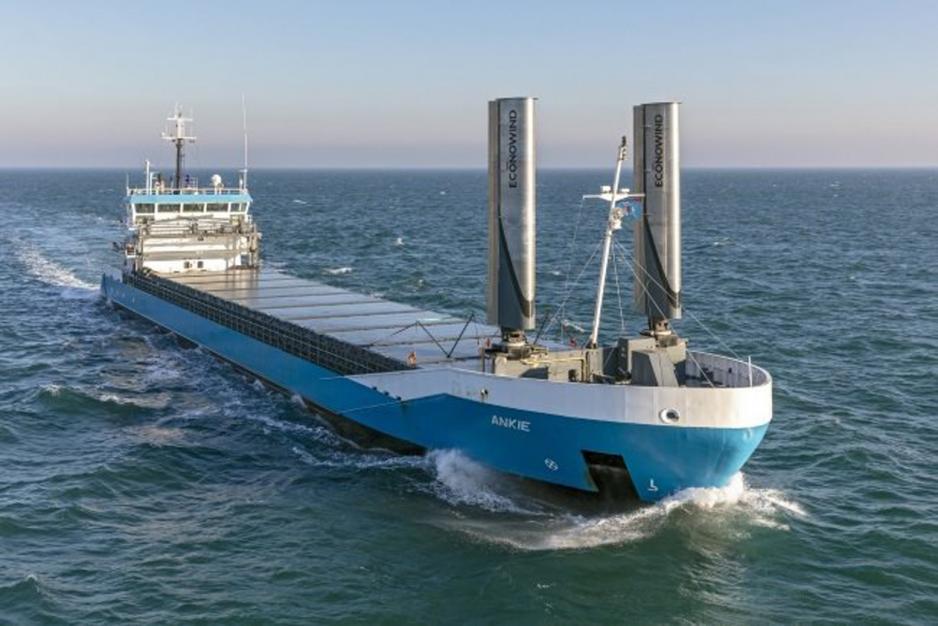Want to Use Wind to Lower Emissions in Shipping

The WASP project and new technology: The container ship Ankie from Van Dam Shipping in the Netherlands sailing. (Photo: Marine Traffic)
“Increased use of wind-assisted propulsion at sea has the potential to reduce climate gases and use of heavy-fuel oil”, says Researcher Ning Lin at Nord University.
Using wind to power ships and referring to it as innovation is probably equal to claiming to having re-invented the wheel.
However, the fact is that for the first time ever, there is current research on wind-assisted propulsion on vessels at sea. The goal is to facilitate low emissions in shipping. Five vessels have already installed new technology and transmit voyage data information to the researchers.
The project is called Wind Assisted Ship Propulsion and is an international project aiming to help bring about the Green Shift in shipping.
Green shipping
“Increased use of wind-assisted propulsion carries the potential to reduce climate gases and the use of heavy-fuel oil (HFO), explains one of the project researchers, Ning Lin ad Nord University Business School.
Associate Professor Roberto Rivas Hermann and Researcher Ning Lin at Nord University Business School. (Photo: Trine Jonassen)
Propulsion using wind requires new technology, however, the shipowners’ wanting to install new technology is a precondition for this technology.
In short, this project consists of three different solutions for wind-assisted propulsion at sea. These three solutions have all been installed onboard the five test vessels owned by Van Dam, Boomsma, Tharsis, Rörd Braren Shipping Company and Scandilines.
The three solutions are Ventifoils or so-called “suction wings”, fixated wing sails and Fletter rotors.
Three years of information gathering
During the next three years, the WASP scientists will map interest among shipowners and present a theoretical framework arguing the case for the selected wind-assisted propulsion.
All the vessels gather information that is passed on to the group of scientists.
“We look at the installation of the various technologies over a certain period of time and the relationship between several decisive factors”, Lin says.
Not tested in the Arctic
“We expect the results to have a major effect on the business regionally as well as internationally” says Project Manager Kasper Uithof from Netherlands Maritime Technology (NMT).
Through collecting extensive data about propulsion by wind power, the project group gets valuable information. The idea of the WASP project is to contribute to a greener transportation system in the North Sea region.
So far, this technology has not been tested on cargo and cruise vessels in Arctic waters such as along the Northern Sea Route. However, Associate Professor Roberto Rivas Hermann at Nord University Business School says there is a major potential for Arctic cruise operators wanting to offer green cruises.
“There is a certain interest, and we would like this technology to also be tested in the Arctic, where the Green Shift is particularly important”, Hermann says.
Separate Arctic package
However, a brand-new program packages will be needed to test the concept in the Arctic.
“We are talking ice class, navigation, wind conditions and everything else that has to be adapted to Arctic conditions”, says the associate professor.
“Wind power combined with fuels such as hydrogen and electricity will significantly reduce emissions.”
Are there any shipowners who build ships with this new technology?
“Not yet. So far, it has been about rebuilding old vessels, since the technology is still in a trial phase”, Hermann says.
The project has received funding from the EU and is to inform about the development of the policy in the EU.
“The results may contribute to easing the development of equal competitive conditions for those using wind-assisted technology. It will simplify integration of wind power and de-carbonization of shipping all over the region”, Kasper Uithof argues.
About Wind Assisted Ship Propulsion (WASP)
A collaboration between 14 partners from seven different countries in the North Sea region: the Netherlands, Belgium, Germany, Denmark, Norway, Sweden and Great Britain. They are to coopeate for three years.
WASP is funded by the Interreg North Sea Europe program under the European Regional Development Fund (ERDF), worth € 5.4 million.
The project partners are universities, technology suppliers in wind-assisted propulsion, as well as shipowners.
The collaboration tests and validated the operational performance of a selection of solutions for wind power propulsion.
The goal is for this technology to become market friendly and contribute to a greener transport system.
The goal of the program is to promote development and innovative products, services and processes to expedite a greener North Sea region.
This article was originally published in Norwegian and has been translated by HNN's Elisabeth Bergquist.


